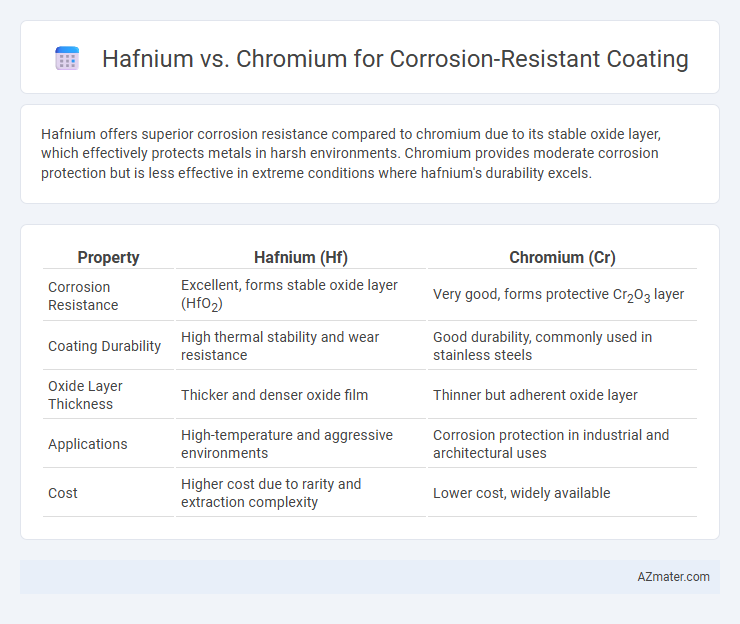Hafnium offers superior corrosion resistance compared to chromium due to its stable oxide layer, which effectively protects metals in harsh environments. Chromium provides moderate corrosion protection but is less effective in extreme conditions where hafnium's durability excels.
Table of Comparison
| Property | Hafnium (Hf) | Chromium (Cr) |
|---|---|---|
| Corrosion Resistance | Excellent, forms stable oxide layer (HfO2) | Very good, forms protective Cr2O3 layer |
| Coating Durability | High thermal stability and wear resistance | Good durability, commonly used in stainless steels |
| Oxide Layer Thickness | Thicker and denser oxide film | Thinner but adherent oxide layer |
| Applications | High-temperature and aggressive environments | Corrosion protection in industrial and architectural uses |
| Cost | Higher cost due to rarity and extraction complexity | Lower cost, widely available |
Introduction to Corrosion-Resistant Coatings
Corrosion-resistant coatings enhance the durability of metal surfaces by protecting them from oxidation and environmental degradation. Hafnium-based coatings offer superior resistance to high-temperature oxidation and corrosion due to their stable oxide layer formation. Chromium coatings provide excellent corrosion protection through a dense, passivating chromium oxide film, making both metals critical choices depending on specific application requirements.
Overview of Hafnium as a Coating Material
Hafnium offers exceptional corrosion resistance due to its dense oxide layer, which protects underlying metals in harsh environments such as chemical processing and aerospace applications. Its high melting point and excellent mechanical stability enable durable, long-lasting coatings that outperform traditional materials like chromium in extreme conditions. Hafnium's compatibility with various substrates and superior resistance to oxidation and acidic media make it an advanced choice for protective coatings in highly corrosive settings.
Chromium: Properties and Applications in Coatings
Chromium exhibits exceptional corrosion resistance due to its ability to form a stable, adherent oxide layer that protects surfaces from environmental degradation. Its high hardness and wear resistance make chromium coatings ideal for industrial applications, including automotive parts, aerospace components, and decorative finishes. Chromium's versatility in electroplating and thermal spray processes enhances surface durability while maintaining aesthetic appeal in protective coatings.
Corrosion Resistance Comparison: Hafnium vs Chromium
Hafnium exhibits superior corrosion resistance compared to chromium, especially in extreme environments such as high-temperature oxidation and acidic conditions. Hafnium forms a stable and dense oxide layer that effectively protects the underlying metal from aggressive chemicals, whereas chromium's oxide layer is less stable under prolonged exposure. This makes hafnium coatings more durable and reliable for applications requiring enhanced corrosion protection.
Mechanical Properties and Durability
Hafnium coatings exhibit superior mechanical properties and outstanding durability compared to chromium, due to hafnium's high melting point (2233 degC) and excellent hardness, which enhance resistance to wear and deformation under extreme conditions. Chromium, widely used for corrosion-resistant coatings, offers good hardness and moderate durability but is more prone to oxidative degradation and mechanical wear over prolonged exposure. Hafnium's ability to form stable, dense oxide layers significantly improves corrosion resistance and longevity in harsh environments, making it a preferred choice for advanced protective coatings requiring enhanced mechanical strength and long-term durability.
Environmental Impact and Safety Considerations
Hafnium offers superior corrosion resistance and lower toxicity compared to chromium, reducing environmental hazards during coating application and disposal. Chromium, particularly hexavalent chromium, poses significant health risks and environmental contamination due to its carcinogenic and mutagenic properties. Selecting hafnium-based coatings enhances safety in industrial processes while minimizing ecological damage and regulatory compliance costs.
Cost Analysis: Hafnium vs Chromium Coatings
Hafnium coatings typically exhibit higher corrosion resistance but come with significantly greater material and processing costs compared to chromium coatings. Chromium coatings remain more cost-effective due to abundant availability and established deposition techniques, making them favorable for large-scale industrial applications. Evaluating total cost of ownership, including durability and maintenance frequency, is crucial to determine the most economical choice between hafnium and chromium corrosion-resistant coatings.
Industrial Applications and Performance
Hafnium coatings exhibit superior corrosion resistance compared to chromium in high-temperature and aggressive chemical environments, making them ideal for aerospace, nuclear reactors, and chemical processing industries. Hafnium's excellent stability against oxidation and resistance to acidic and saline media enhances the longevity and durability of industrial components. Chromium coatings, while effective for moderate corrosion resistance and valued for cost-efficiency, often fall short in extreme industrial conditions where hafnium outperforms due to its dense oxide layer and high melting point.
Future Trends in Corrosion-Resistant Coating Technologies
Hafnium offers superior corrosion resistance due to its high melting point and excellent chemical stability, making it a promising alternative to chromium in advanced coating applications. Future trends in corrosion-resistant coating technologies emphasize the development of environmentally friendly, non-toxic materials, with hafnium-based coatings gaining traction for their durability and enhanced protective properties. Research is increasingly focused on nano-engineered hafnium coatings and hybrid composites to extend service life in harsh industrial environments while complying with stricter environmental regulations.
Conclusion: Selecting the Optimal Material
Hafnium exhibits superior corrosion resistance and oxidation stability compared to chromium, making it a prime candidate for high-performance coatings in aggressive environments. Chromium, while cost-effective and widely used, lacks the enhanced durability and thermal stability that hafnium offers. Selecting hafnium for corrosion-resistant coatings leads to longer lifespan and better protection in extreme conditions, justifying its higher initial cost.

Infographic: Hafnium vs Chromium for Corrosion-resistant Coating
 azmater.com
azmater.com